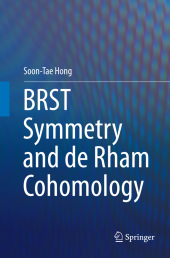 Neuerscheinungen 2016Stand: 2020-02-01 |
Schnellsuche
ISBN/Stichwort/Autor
|
Herderstraße 10
10625 Berlin
Tel.: 030 315 714 16
Fax 030 315 714 14
info@buchspektrum.de |

Soon-Tae Hong
BRST Symmetry and de Rham Cohomology
Softcover reprint of the original 1st ed. 2015. 2016. x, 201 S. 2 SW-Abb., 9 Tabellen. 235 mm
Verlag/Jahr: SPRINGER NETHERLANDS; SPRINGER 2016
ISBN: 9402404015 (9402404015)
Neue ISBN: 978-9402404012 (9789402404012)
Preis und Lieferzeit: Bitte klicken
This book provides an advanced introduction to extended theories of quantum field theory and algebraic topology, including Hamiltonian quantization associated with some geometrical constraints, symplectic embedding and Hamilton-Jacobi quantization and Becci-Rouet-Stora-Tyutin (BRST) symmetry, as well as de Rham cohomology. It offers a critical overview of the research in this area and unifies the existing literature, employing a consistent notation.
Although the results presented apply in principle to all alternative quantization schemes, special emphasis is placed on the BRST quantization for constrained physical systems and its corresponding de Rham cohomology group structure. These were studied by theoretical physicists from the early 1960s and appeared in attempts to quantize rigorously some physical theories such as solitons and other models subject to geometrical constraints. In particular, phenomenological soliton theories such as Skyrmion and chiral bag models have seen a revival following experimental data from the SAMPLE and HAPPEX Collaborations and these are discussed. The book describes how these model predictions were shown to include rigorous treatments of geometrical constraints because these constraints affect the predictions themselves. The application of the BRST symmetry to the de Rham cohomology contributes to a deep understanding of Hilbert space of constrained physical theories.
Aimed at graduate-level students in quantum field theory, the book will also serve as a useful reference for those working in the field. An extensive bibliography guides the reader towards the source literature on particular topics.
Preface.
1. Introduction.
2. Hamiltonian quantization with constraints.
2.1 Hamiltonian quantization of free particle on sphere. 2.2 Hamiltonian quantization of free particle on torus.
3. BRST symmetry in constrained systems.
3.1 BRST symmetry in free particle system on sphere. 3.2 BRST symmetry in free particle system on torus.
4. Symplectic embedding and Hamilton-Jacobi quantization.
4.1 . Symplectic embedding of free particle system on torus. 4.2 Hamilton-Jacobi quantization of nonholonomic system. 4.3 Symplectic embedding and Hamilton-Jacobi analysis of Proca model.
5. Hamiltonian quantization and BRST symmetry of soliton models.
5.1 Hamiltonian and semi-classical quantization of O(3) nonlinear sigma model. 5.2 Schrodinger representation of O(3) nonlinear sigma model. 5.3 BRST symmetry in SU(3) linear sigma model. 5.4 BRST extension of Faddeev model.
6. Hamiltonian quantization and BRST symmetry of Skyrmion models.
6.1 Hamiltonian quantization of SU(2) Skyrmion. 6.2 BRST Symmetry of SU(2) Skyrmion. 6.3 Hamiltonian quantization of SU(3) Skyrmion. 6.4 Flavor symmetry breaking effect on SU(3) Skyrmion.
7. Hamiltonian structure of other models.
7.1 Bosonization of QCD at high density. 7.2 Gauge symmetry enhancement of enlarged CP(,N) model.
8. Phenomenological soliton.
8.1 Sum rules for strange form factors and flavor singlet axial charges. 8.2 Sum rules for baryon decuplet magnetic moments.
9. De Rham cohomology in constrained physical system.
9.1 De Rham cohomology in algebraic topology. 9.2 De Rham cohomology in ´t Hooft-Polyakov monopole.
Appendix.
"This book is not only an advanced introduction to the extended theories of quantum field theory and algebraic topology but also a research platform which the interested reader are guided in a straightforward path to the frontier of the current research in the field. I recommened this book as an excellent resource for graduate and postgraduate students as well as researchers in quantum field theory." (Saeid Jafari, zbMATH, Vol. 1326.81004, 2016)


